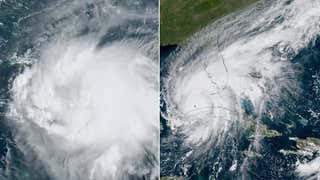

US
°C





While not as severe as last year, Lake Erie is expected to have a severe harmful algae bloom this summer.The algae can prove harmful to swimmers and pets.
Western Lake Erie will experience a "significant" harmful algal bloom this summer, NOAAand its research partners said Thursday.
The announcement came during a press conference at the Ohio State Stone Laboratory, located on Gibralter Island on Lake Erie.
While the bloom is predicted to be smaller than 2015, it will be in the top five largest blooms, according to .
On the severityindex, which measures the blooms biomass or amount of harmful algae over a sustained period, the bloom is expected to measure 7.5 over on a scale of oneto 10, but could range between six and 9.5, scientists say.
The largestblooms, which occurred in2011 and 2015, andwere recorded at 10 and 10.5, respectively.
“A bloom of this size is evidence that the research and outreach efforts currently underway to reduce nutrient loading, optimize water treatment, and understand bloom dynamics need to continue,” said Christopher Winslow, director of the. “Despite the predicted size of this year’s bloom, much of the lake will be algae free throughout the bloom season and the lake remains a key asset for the state.”
While NOAA does not forecast for toxicity, the HAB could still pose a threat to swimmers and pets, Rick Stumpf, NOAA’s lead oceanographer for the Lake Erie bloom forecast, told the Port Clinton News-Herald.
Environmental groups have voiced their concern following the news.
Algae washes ashore off South Bass Island State Park, Ohio, in Lake Erie July 29, 2015. The algae bloom turned the water green at the park.
(Eric Albrecht/The Columbus Dispatch via AP)
“Harmful and toxic algal blooms in western Lake Erie have contaminated drinking water, closed beaches, and hurt our fishing and tourism industries.” Charlotte Jameson, government affairs director for Michigan League of Conservation Voters, . “NOAA’s forecast reminds us that Lake Erie’s algae problem has not gone away and that we can’t just hope for dry springs as a solution. Unfortunately, Michigan seems to be determined to do just that, missing every opportunity to craft a plan that stands a chance at bringing this Great Lake back to health.”
(MORE: )
While climate change plays a large role in the development of these blooms, environmentalists say that agriculture is the main culprit.
A report released by Environment America states that, 1 million acres of lakes and reservoirs, and 3,000 square miles of bays and estuaries to the point where they can’t be used for swimming, fishing, drinking water or maintaining healthy wildlife.
Many farmers are making efforts to curb algae-causing pollution and runoff, but the more needs to be done, including the reduction in the amount of manure and fertilizer used.
"The governments of Canada and the United States, along with Michigan, Ohio and Ontario need to do much more to solve the problem,” Nancy Goucher, Manager of Partnerships with Freshwater Future, said. “We’re likely to continue to see devastating impacts without a concerted effort by all Lake Erie jurisdictions to curb runoff pollution.”
MORE ON WEATHER.COM: Lake Erie Algae, 2015
The western end of Lake Erie now has a greenish tint, recent satellite images show. Close-ups show the area between northwest Ohio, southeast Michigan and the far southwestern portion of Ontario.












